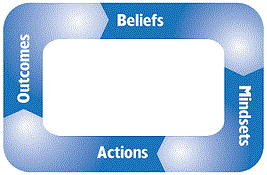It's logical that patients have a more positive experience when employees are engaged in their work.
According to The Beryl Institute (http://www.theberylinstitute.org/), patient experience is defined as "The sum of all interactions, shaped by an organization's culture, that influence patient perceptions across the continuum of care." Today, I write about a key strategy that you can implement as a healthcare leader to impact engagement and the patient experience.
In my book, 6 Shortcuts to Employee Engagement: Lead & Succeed in a Do-More-With-Less World, I share a paradigm that shows that beliefs and mindsets drive actions and outcomes. At face value, this may seem basic; however, in healthcare we often spend time naming the desired outcomes and creating lists of actions to achieve them without regard for employees' beliefs and mindsets. This negatively impacts engagement and ultimately the patient experience.
Here's a key strategy to positively impact each employee's ability to be satisfied, energized & productive (AKA engaged) at work. At the next meeting about patient experience, when action plans are created, stop and ask this question. "What beliefs and mindsets support and/or get in the way of this action happening?" Please note, you'll need to have folks in the room who are doing the work so that they can illuminate you with the answer. Otherwise, you're just making assumptions and you might miss out on hidden beliefs and mindsets. On another note, employees need to trust you or they won't share the beliefs and mindsets that might get in the way. It must be okay to reveal their thoughts.
Let's take creating a quiet environment for the patients as an example. You're in a meeting to discuss ways to keep things quiet. The multi-disciplinary leadership team comes up with a list of "to-do's" including things like dimming the lights, turning down PA speaker volumes, talking in quiet tones, etc. These actions seem reasonable and no one needs special training to make the desired changes. Your team rolls out the initiative, you even create a clever video to illustrate how these things are a good idea, etc. Then nothing changes.
It's not because your action items weren't evidence-based or well thought out. It's not because the education wasn't effective or that people don't know how to do what you are asking. It's because for some reason, they believe that the actions are not that important. Actions and behaviors reflect beliefs and mindsets. If we think something is important, we will do it despite obstacles.
Imagine the meeting going differently. First, the key stakeholders are in the room (night shift nurses, techs, housekeeping, security, etc.). Next you ask the group, "What are your beliefs about having a quiet environment for patients?" ...and why. As you listen, you'll hear many "right answers" as to why it's important. That's the great news. Make a list for reference.
Now ask the second question..." What beliefs might get in the way of having a quiet environment on a consistent basis?" Now you'll hear the real obstacles that will get in the way. Follow up by asking the staff their ideas for changing these beliefs.
If you want to impact the patient experience, start by learning more about employees' beliefs and mindsets. Employee engagement is heavily influenced by the marriage of external circumstances and internal beliefs about those conditions. Better understanding beliefs helps everyone improve their own work experience and the patient experience as well.
Vicki Hess, RN, is your go-to resource for transforming employee engagement in healthcare at the individual, department or organization-wide level. As the author of four books, creator of the Engagement Excelerator Virtual Coaching Program, Certified Speaking Professional (CSP), trainer and consultant; Vicki inspires healthcare leaders to take action in a real-world, relatable way. Organizations that implement Vicki's ideas experience increased engagement, productivity, safety, quality, retention, patient satisfaction, creativity and more. Access free tools and resources when you visit www.HealthcareEmployeeEngagement.com.
The views, opinions and positions expressed within these guest posts are those of the author alone and do not represent those of Becker's Hospital Review/Becker's Healthcare. The accuracy, completeness and validity of any statements made within this article are not guaranteed. We accept no liability for any errors, omissions or representations. The copyright of this content belongs to the author and any liability with regards to infringement of intellectual property rights remains with them.


